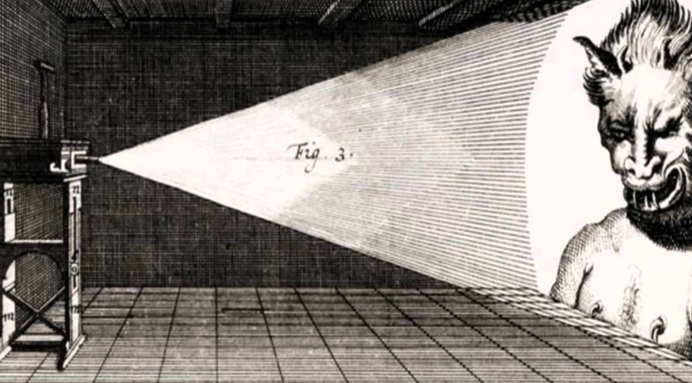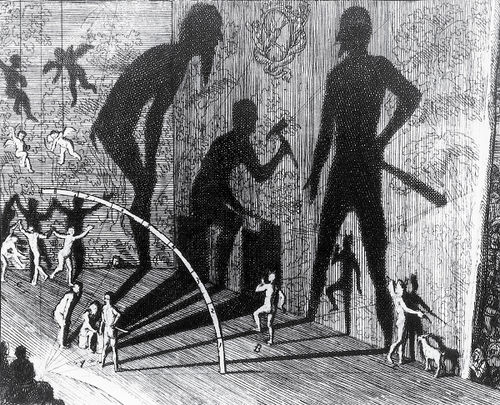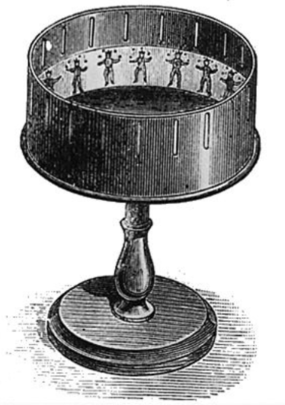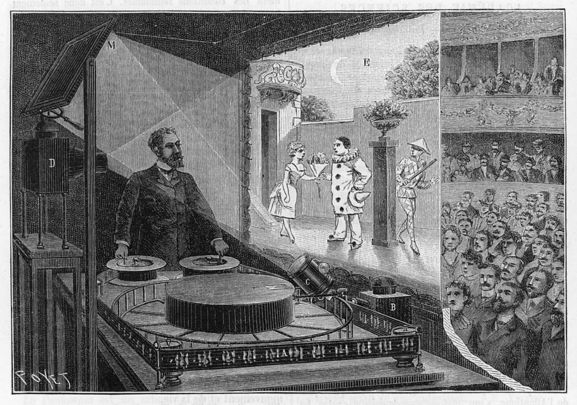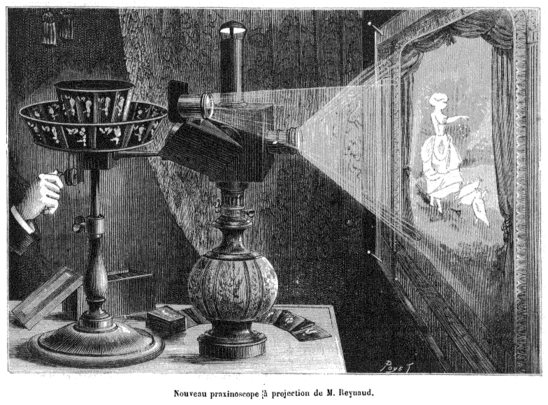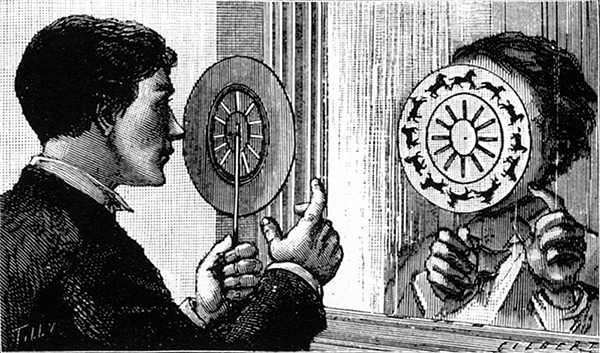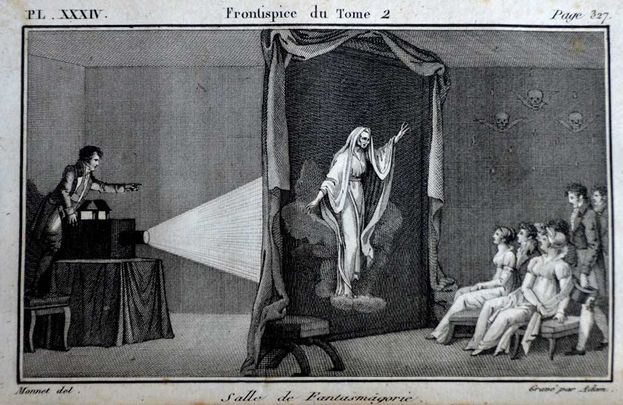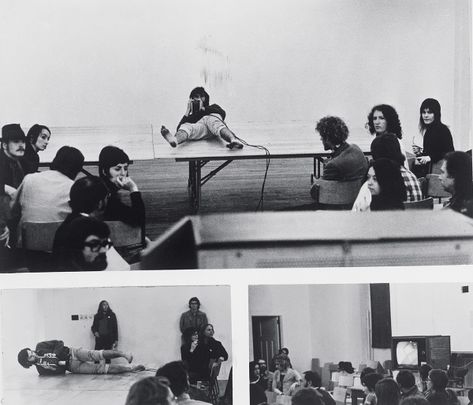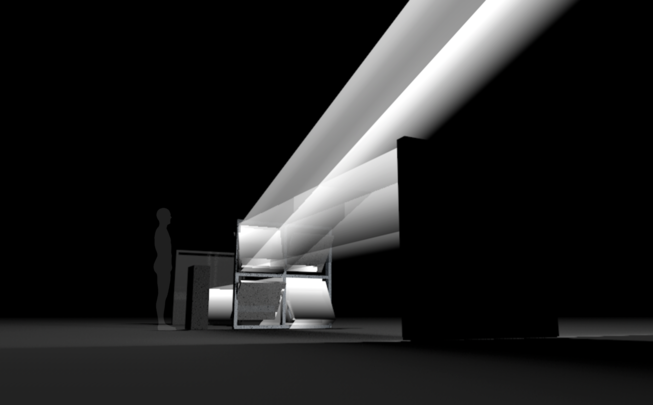User:Zalán Szakács/projectproposal3
Graduation Project Proposal Draft 3
01 | 11 | 18
Eigengrau (project working title)
(German: "intrinsic gray", lit. "own gray"; pronounced [ˈʔaɪ̯gn̩ˌgʁaʊ̯]), also called Eigenlicht (Dutch and German: "own light"), dark light, or brain gray, is the uniform dark gray background that many people report seeing in the absence of light.
What do you want to make?
I am fascinated by the epoch of the 19th century, the pre ages of the cinema, where humans created different spatial illusional models of bringing dead materials of photographs and paintings alive through inventions such as zoetropes, praxinoscopes and phantasmagorias. These were early intentions, where through mechanical or human movements projections appeared on the stage. The public was entertained by subjects such as the supernatural, where ghosts and skeletons were the main inspiration sources. Multiple senses were triggered at these events such as vision, audio and tactile.
My goal is to reinterpret these media objects into our contemporary context, called as well post-digital spaces. This term could be described as physical spaces build by digital components such as custom made softwares, sensors, digital interactions, algorithms, where the digital merges with the physical, creating a hybrid environment. New perceptions will be triggered through technology in a physical space.
The phenomenology of space should be mentioned of which Michael Foucault wrote that it taught us “that we do not live in a homogenous and empty space, but rather in a space that charged with qualities, which may also be populated by phantasms. The space of our dreams, the space of our passions - they contain a kind of inner quality.”1
Searching the answer for the following main question: How do new sensory installations allow for new forms of experience and understanding?
Followed by subquestions such as: How could light become a communicational media? To what extend is politically correct to influence and trigger human emotions through light?
The intentions behind the project Eigengrau is that it pushes the boundaries of different human spatial illusion effects with very basic elements such as light, haze, sound. Searching the solution for this question: How could I achieve a big impact on the audience with these basic elements?
Goal is to unter take weekly experiences with different LED strips, where different characteristics of light will be analysed such as speed, luminance, color, motion, rhythm, structure and vibration. These tests would help me to formulate my answers to my main question, which would create a good foundation for the final light installation. Focus will be to trigger visual and audible senses of the audience.
The interactive installation consists out of 6 main elements: 2 LED square walls on the left and the right side, an interactive mirror wall consisting out of 4 parts, a motion sensor podium(?), a haze machine, and a 4D sound system which surrounds the installation.
It invites it's audience to interact through hand movements with the light and the mirrors for creating different audiovisual experiments and sensory climaxes. Each hand movements triggers a specific sound scape, light intensity and movement (shape) and mirror angle. The reflections of the light would spread in the space into certain angles, while constructing spatial illusion phonemes. The audience will merge into a new sensory experience and will make us aware our body awareness, perception and extension of our body through technology.
At most of the art and audiovisual performances the artist is in charge of the storyline of the show. Eigengrau represents new ways how audience could become the performer itself. Through experimental body moments and help of motion sensors the audience collaboratively is creating actions for the performative installation.
What are post digital spaces?
Post digital spaces are composed out 2 main characteristics:
- Interface
Through experimental body moments and will help of a motion sensor you will be able to adjust to environments in digital spaces - internet spaces. Our human understanding is not programmed of moving 2D icons on the desktop rather using our body in physical space to give commands to the computer. This is a holistic way of looking at human body.
- Network
Everyone will have a different role in creating the performative installation. Collaboratively they interact with the light and their own reality in spatial illusion.
How do we perceive things? There is no objective truth. Emphasising the subjective reality.
The audience is creating it's own reality. The reality on the internet doesn't show the reality of the internet. It shows to it's audience a customised subjective reality.
This installation manifests a new understanding about the post digital spaces and the importance of light for its audience. It sets its goal to create a community around this term and make it more accessible this installation for a broader audience.
How does this work differentiates itself from other light installations?
- by it's critical view on interaction and the use of technology
- the way of the interaction
- the audience becomes the performer
- interplay of the surfaces (left and right LED part) creating a unique spatial composition
- by its simplicity
How do you plan to make it?
Firstly I am investigating into two research ways:
- Literature for the thesis (research consists of books and articles around media archaeology, philosophy, psychology light, brain, emotions, space, human perception and technology)
- Prototyping for the graduation project (artistic, hardware and software, Arduino, LED)
What is your timetable?
September – October 2018: Research + Prototyping
November – December 2018: Prototyping & human testing with sensors, some parts are in 1:1 scale
January – February 2019: Finalisation of the installation parts: technical drawing, final software
March – April 2019: Production of the final installation
May 2019: Testing and documenting the process
June 2019: Buffer time
July 2019: Graduation Show
Why do you want to make it / Relation to previous practice
Working for many years as a VJ, where I always want to challenge human perceptions through different visual and phenomenal illusions for new forms of understanding. My goal is to provoke the audience and take them on journey through different emotional climaxes from very dark emotions till happiness. The last 30 minutes and the last 5 minutes of my shows are the most important parts for me, because these moments people will remember after the performances.
Since the antiquity humans were fascinated by light and it’s illusionary characteristics, as illustrated by the metaphor of Plato’s Cave. Around the fifteenth century, perspective and camera obscura were invented and since then this spatial depiction has become the norm to all other visual representations. Joost Rekveld writes in 2007 the following about these discoveries: 'Perspective was accepted as a ‘scientific’ and true method based on optics, but also as a model of how people could observe space. Gradually people realised that perspective was mostly about a way of looking at reality.' 2
Towards the end of nineteenth century non-euclidian geometry was discovered by mathematicians such as Friedrich Gauss, Nikolai Ivanovich Lobachevsky, Janos Bolyai and this brought up the concept of the fourth dimension, the concept of time in relationship with space.
Movement and light became an important motivation for the artists and designers from Bauhaus such as Laszlo Moholy-Nagy.
The digital developments of the twentieth century brought mankind new spatial perception such as Cyberspace. 'This space appears to be real and at the same time not geometric or not real in any physically determined way. We use completely new concepts to visualise or understand this space: rhizomes, networks consisting of nodes without any hierarchy, etc.' 3 (Rekveld, 2007)
In 1970 the Artist Dan Graham coined the term “cyberspace” by this he meant a space which is meditated through the feedback technology of video tape; It was Graham who –11 years before William Gibson used it – coined the term “cyberspace” to describe the new inter-subjective technological space created by the interaction of humans within a video mediated circuit” 4 (William Kaizer, 2008)
Bateson's media ecology puts on display the ways in which formats limit communication, exposing how the techno-social context of communica- tion is as relevant as any content. In a similar way, in 1964 Marshall McLuhan announced that "the medium is the message." But if McLuhan takes technologi- cal formats to be "extensions of man," Bateson goes further. He gives up any notion of man, redefining the self as an expanded mental field in which the sub- ject and its objects are no longer separable. For Bateson, "mind" is no longer bounded by the individual body, becoming a conjunction of self and world produced through communicative ecologies. 5 (William Kaizer, 2008)
After the millenium humans desired new understandings of spatial concepts as called ‘post-digital spaces’. These are psychical spaces build by digital components such as custom made software, sensors, digital interaction, where the digital merges with the physical, creating a hybrid environment. Human senses are triggered by these elements, while creating new sensory experiences, which have been deeply researched and experimented by scientist and artist in 1960’s such as James Turrell in his Ganzfeld Effect spaces.
Our everyday life is deeply interwoven with screens and interfaces therefor there is a tendency and desire to break out of them.
Who can help you and how?
PZI staff: Javier Lloret (LED), Steve Rushton (Theory)
Children of the Light: Arnout Hulskamp, Christopher Gabriel (LED)
Sound:frame: Eva Fischer (Theory)
Relation to a larger context
roiji ikeda
james turrel
nonotak
joris strijbos
uva
strp biennale
atonal berlin
mutek montreal
ctm festival
todaysart
china light festival
ars electronica
sonic acts
algorave
live coding culture
algorithms from nature
References
Reading
Sources
1 Hattinger, Gottfried, "Artificial Spaces, Vienna: k/haus, Schlebrügge.Editor,2010.
2 Joost Rekveld 2007, Mental Spaces, viewed 15 October 2018, <http://www.joostrekveld.net/wp/?page_id=590>
3 Joost Rekveld 2007 Mental Spaces, viewed 15 October 2018, <http://www.joostrekveld.net/wp/?page_id=590>
4 Steps to an Ecology of Communication: Radical Software, Dan Graham, and the Legacy of Gregory Bateson; William Kaizen: Art Journal, Vol. 67, No. 3 (FALL 2008)
5 Steps to an Ecology of Communication: Radical Software, Dan Graham, and the Legacy of Gregory Bateson; William Kaizen: Art Journal, Vol. 67, No. 3 (FALL 2008)

